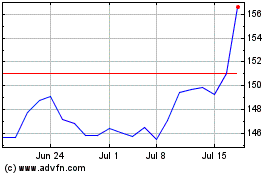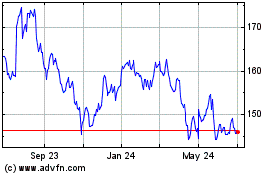Stocks Open Mixed After J&J Vaccine Halted and Inflation Uptick
April 13 2021 - 10:01AM
Dow Jones News
By Anna Hirtenstein
U.S. stocks wobbled Tuesday as investors tried to gauge the
impact of a halt in rolling out Johnson & Johnson vaccines and
an uptick in inflation.
The S&P 500 opened less than 0.1% higher after futures on
the index wavered between gains and losses. The broad market index
on Monday was hovering near its recent record closing high. The
technology-heavy Nasdaq-Composite Index climbed 0.4%, while the Dow
Jones Industrial Average fell 0.2%.
Health authorities recommended a pause in using the Johnson
& Johnson vaccine following reports of blood clotting. The Food
and Drug Administration and the Centers for Disease Control and
Prevention are reviewing data involving six reported cases of
clotting.
"It means the pace at which you reach herd immunity is
decreased, and it will take longer for the reopening of the
economy," said Sebastien Galy, a macro strategist at Nordea Asset
Management.
Fresh data also showed that U.S. consumer prices picked up
sharply in March as the economic recovery gained momentum, partly
reflecting higher gasoline prices. The Labor Department reported
that the consumer-price index jumped 2.6% in the year ended
March.
Investors in both stocks and bonds are seeking to assess whether
the projected U.S. economic recovery will trigger a sharp rise in
inflation that may remain for a protracted period. Policy makers
have repeatedly said they expect any increase over the next few
months will prove to be fleeting. An uptick in inflation
expectations earlier this year led to a rise in bond yields, and
damped appetite for richly valued technology stocks last month.
"The equity market is a bit stretched in valuation," Ludovic
Subran, chief economist at Allianz, said before the inflation data
was released. "If yields are going a bit higher on the back of
stronger inflation, a lot of institutional investors could rotate
their portfolios out of very risky equities to less risky bonds and
still get quite a comfortable margin."
In bond markets, the yield on the 10-year Treasury note ticked
down to 1.666%, from 1.674% on Monday. Yields rise when bond prices
fall. The 10-year yield shot up as high as 1.749% at the end of
March, from 0.915% near the start of the year.
Monica Defend, global head of research at asset manager Amundi,
said she expects more volatility in the bond market this year.
"This is what we worry about the most," Ms. Defend said.
"Inflation expectations will play a role at the same time as growth
will be tested, in terms of the robustness of the recovery."
Higher bond yields could weigh on equity markets by creating a
more attractive alternative to stocks, she said. But stocks will
probably continue to climb as long as the economy grows, even if
inflation moves higher, she added.
Brent crude, the international gauge for oil, climbed 1% to
$63.92 a barrel. A brightening outlook and stimulus packages will
boost economic activity and oil demand this year, the Organization
of the Petroleum Exporting Countries said Tuesday.
Overseas, the pan-continental Stoxx Europe 600 was relatively
flat.
In Asia, most major benchmarks rose by the close of trading.
Japan's Nikkei 225 Index added 0.7% and Hong Kong's Hang Seng Index
advanced 0.2%.
The Shanghai Composite Index retreated 0.5% after data showed
that Chinese exports in March had risen less than economists had
expected, resulting in a smaller trade surplus than
anticipated.
Bitcoin rose over 4% to a record, trading above $63,000 apiece,
according to data from CoinDesk. Coinbase, the largest U.S.
cryptocurrency exchange, is planning to go public on Wednesday.
Write to Anna Hirtenstein at anna.hirtenstein@wsj.com
(END) Dow Jones Newswires
April 13, 2021 09:46 ET (13:46 GMT)
Copyright (c) 2021 Dow Jones & Company, Inc.
Johnson and Johnson (NYSE:JNJ)
Historical Stock Chart
From Mar 2024 to Apr 2024

Johnson and Johnson (NYSE:JNJ)
Historical Stock Chart
From Apr 2023 to Apr 2024
